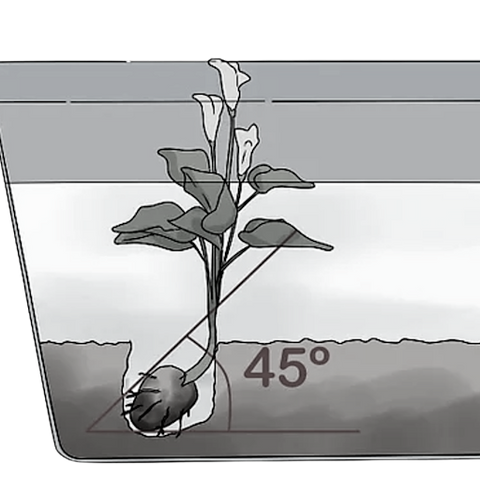Water lilies, with their captivating blooms and floating pads, bring an undeniable touch of elegance to any pond or aquatic garden. As symbols of tranquility and natural beauty, these enchanting plants require thoughtful care to thrive and showcase their full splendor. In this guide, we'll explore the art of water lily care, ensuring your aquatic garden becomes a haven of serenity and breathtaking blooms.
Set-Up
1. Plant water lilies in containers instead of directly in the ground. Use a wide, shallow pot or a mesh basket designed for aquatic planting. The container should have a diameter of 14 to 16 inches (36 to 41 cm).
It’s easier to maintain potted lilies, especially if you need to move them. Additionally, a lily planted directly into the ground could eventually overwhelm your pond. When planted in the ground, a water lily’s root system can cover a diameter of 15 feet (4.6 m) within 5 years.
You can find aquatic plant necessities, including a mesh basket and aquatic soil, online, at your local garden center, or at a home improvement store.
2. Use an aquatic planter or container if you don’t have a pond. If you have one, you can plant lilies in your pond or backyard water feature. If not, purchase a large aquatic planter or container, fill it with water, and submerge the pot that holds the lily.
Go for an aquatic planter that’s around 6 by 8 feet (1.8 by 2.4 m). Make sure it’s designed for aquatic plants and doesn’t have any drainage holes.
3. Ensure your pond or container gets at least 6 to 8 hours of full sun. While lilies need a minimum of 6 hours of direct sunlight, more light encourages them to produce more flowers. Ideally, your lilies should get at least 8 hours of sun.
4. Plant your lilies in the spring. Late April to early May is the best time to plant water lilies in the Northern Hemisphere. In cooler climates, plant when there’s no risk of frost.
There are 2 varieties of water lily: hardy and tropical.
As their name implies, hardy water lilies can tolerate cooler temperatures. You still need to plant them in the spring, but maintaining a high water temperature isn’t as important.
5. Make sure your pond is warm if you choose tropical lilies. Tropical species can’t tolerate water temperatures below 65 °F (18 °C), so make sure your pond or aquatic container can sustain warm water before planting. Ideally, your water should be at least 70 °F (21 °C).
Planting your water lily.
1. Fill 3/4 of your lily pot or basket with aquatic loam-based soil, then add fertilizer. Line your pot or aquatic basket with a coarse fabric, such as hessian or burlap. Use a loam-based soil labeled for aquatic use, as standard potting soil is too fluffy and will float away when submerged.
Add soil to the container until it’s 3/4 full, then add aquatic fertilizer.
The right amount of fertilizer depends on your product, so read the instructions for the fertilizer you purchase. A typical ratio is 10 grams (about 1/3 oz) of fertilizer for 1 gallon (3.8 L) of soil.
2. Remove the lily from its bag and trim it. Gently pull the lily out of the bag it arrived in and rinse away any excess soil from its rhizome, or root system. Trim any old, fleshy roots with pruning shears, but leave white, hair-like roots intact.
Trim away all old, fleshy roots. If you don't see any, you can skip trimming.

3. Place the root ball in the soil at a 45 degree angle. Set the lily's root ball on top of the soil on the side of the container. Make sure the crown, or the part where the stems emerge, points at a 45 degree angle toward the center of the pot.
If your lily hasn’t matured and has a growing tip instead of stems, position the growing tip at the same level as the top of the soil.
4. Add more soil and a top layer of pea gravel. Add more soil, but don’t completely fill the container. Leave about 1 to 2 inches (2.5 to 5.1 cm) between the top of the soil and container’s rim. Lightly press the soil to pack it, then add a layer of pea gravel to help keep the soil from floating away.
Rinse the pea gravel thoroughly before you add it. Also, make sure you don’t pack the gravel tightly around the stems. If your lily isn’t mature, leave a space in the gravel for the plant’s growing tip, which should be level with the top of the soil.
5. Water it well, then submerge the container in water. Soak the pot completely with a hose, then lower it into your pond or aquatic planter.
For the first 3 to 4 weeks, submerge the pot so that 5 to 6 inches (13 to 15 cm) of water covers the crown and young leaves float on the water’s surface. If necessary, stack bricks or other supports to keep the pot at the right height. Keeping the pot at a shallow height will encourage growth.
When you submerge the container in water, lower it into the water at an angle so that air trapped inside can escape.
Maintaining Your Lilies
1. Place the container at gradually deeper water levels. After about 3 weeks, lower the pot so 8 to 10 inches (20 to 25 cm) of water covers the crown. As it grows, gradually lower it until 12 to 18 inches (30 to 46 cm) of water covers the crown.
2. Remove old flowers and leaves before they rot. If you plant in spring, you should see flowers by June. Flowers last 3 to 4 days, and should be trimmed and removed when they whither. You should also remove old leaves to prevent rot. Deadheading, or removing old flowers and leaves, will help keep your water clear and encourage new flowers to form.
3. Fertilize lilies monthly during the growing season. Lilies are hungry plants, and should be fertilized with a slow release aquatic formula every 4 to 6 weeks. Lift the pot out of the water, and use your fingers to clear out small holes in the gravel and soil. Insert aquatic fertilizer tablets or pellets, then smooth over the gravel and submerge the pot.
The amount of fertilizer to add depends on your product, so check its label for specific instructions. Some aquatic fertilizers specify 1 tablet per 1 gallon (3.8 L) of soil, while other products recommend 2 to 4 tablets for the same amount of soil.
Conclusion
Caring for a water lily is a rewarding endeavor that transforms your aquatic garden into a haven of natural beauty. By providing the right conditions, regular maintenance, and a touch of appreciation, your water lily will reward you with spectacular blooms and a touch of graceful elegance. Happy water lily gardening!


